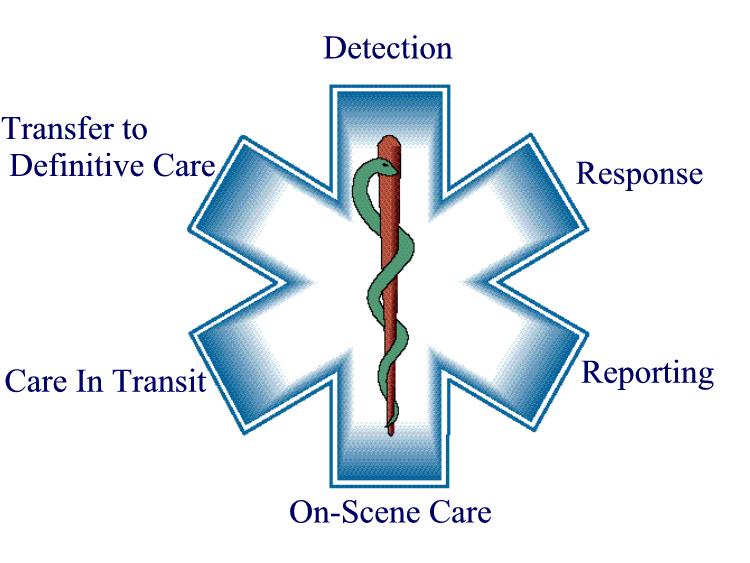
City Of Evansville - WI
EMS FAQ
-
What does EMS stand for?
EMS is an acronym for Emergency Medical Services. The profession was born from the battlefield in the Napoleonic era when Napoleon’s physician Dominque-Jean Larrey used horse-drawn carts as the first ambulance” to move injured soldiers off of the battlefield to a treatment area. The idea made its way to the United States during the Civil War. In WWI, the United States Army used non-physicians in the trenches to treat casualties; in WWII, these men entered combat and became the corpsmen and medics we know today. In the 1950s, civilian programs began developing and by the mid-1960s, the EMS profession in the United States started to take shape.
-
Where did the Star of Life symbol on ambulances come from?
The Star of Life was designed and created by Leo R. Schwartz, Chief of EMS Branch, National Highway Safety Administration (NHTSA).
The blue star outline in white features the rod of Asclepius in the center. Asclepius is an ancient Greek symbol of healing. The star's 6 points represent the 6 phases of an EMS response.

1. Early detection
2. Early response
3. Early reporting
4. On-scene Care
5. Care in transit
6. Transfer to definitive care
-
What do I do while driving when an emergency vehicle approaches with lights and sirens on?
Pull to the right! Wisconsin state law states you must yield the right-of-way to police vehicles, fire apparatus, ambulances or other emergency vehicles using a siren, air horn or a red or blue flashing light.
Pull over to the right edge of the road or as near to the right as possible and stop when you see or hear an emergency vehicle approaching from any direction. Follow any instructions given over the emergency vehicle's loudspeaker.
If you are in an intersection, drive through the intersection before you pull over. If the emergency vehicle using lights or siren is on the other side of a divided highway, you do not need to pull over and stop. You must not pass an emergency vehicle that is about to back into or is backing into the driveway entrance of a Fire and/or EMS station. It is illegal to pass or follow within 500 feet of a moving emergency vehicle with its red or blue lights on and siren operating. This includes while driving on freeways or other limited access highways. When approaching law enforcement and other emergency vehicles, tow trucks, road machinery or highway construction or maintenance vehicles (that are stopped on or near a highway and are using flashing emergency lights), you must move into a lane not nearest the stopped vehicle and travel in that lane until you have gone by the stopped vehicle(s). If it is unsafe to move into another lane, slow down until you have passed the stopped vehicle(s).
-
When should I call 911?
Anytime you feel you have an emergency. If in doubt, call and let us help you decide if you or someone else will need to go to the hospital in an ambulance. However, keep in mind that 911 should only be used for life or limb threatening emergencies.
-
Why does more than just an ambulance come when I call 911?
Depending on the type and the severity of a call, a decision will be made as to what type and number of units will respond to a call. A typical medical call will receive one ambulance. If the call turns out to be a severe emergency, it is very possible that additional resources such as the fire district and police department will be utilized to perform a vital function. At times, the call may be minor and require less personnel. However, once on scene, it is the job of the paramedics to determine the needs of the patient(s).
-
What can I do until help arrives?
There are a few things you can do to help the ill or injured person(s) while you are waiting for help to arrive:
1) Stay calm and reassure the patient that help is on the way.
2) Do what the 911 emergency dispatcher tells you to do. You may also be instructed to perform some basic life-saving skills that you can initiate while EMS/Fire/Police personnel are enroute.
3) Make the patient as comfortable as possible, but, don't place anything underneath their head, like a pillow, to make them more comfortable. This could cause further injury. Never move the patient unless they are in imminent danger where they are.
4) Try and secure any pets so they do not get away or interfere with any EMS/Fire/Police personnel.
5) Have someone available to direct the EMS/Fire/Police personnel to the patient.
-
Why don't the paramedics run to treat patients?
Running is risky – if they were to trip and fall, then they would be of no help to the person who needed them, and they would probably become a patient themselves. Running prevents them from surveying a scene thoroughly, and they might overlook a hazard like a protective dog, a weapon in the room, downed power lines, or similar. Running also elevates their own heart rate and respirations, which does not create a sense of calm for their patients, and makes it difficult for them to think clearly and act deliberately.
